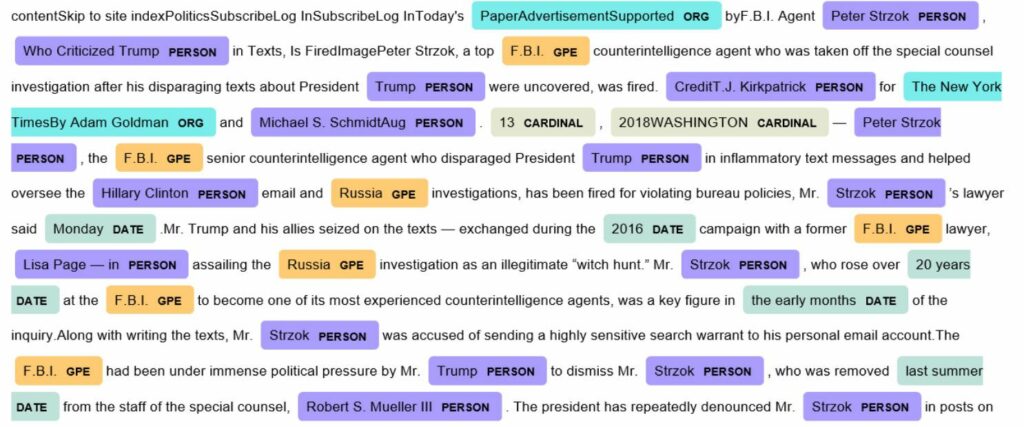TL;DR – Named Entity Recognition (NER) is a process in Natural Language Processing (NLP) that identifies and classifies named entities, such as names of persons, organizations, locations, and other predefined categories, in a given text.

In the ever-evolving domain of Natural Language Processing (NLP), extracting specific information from vast swathes of text is crucial. This extraction task is championed by Named Entity Recognition (NER).
Table of Contents
What is Named Entity Recognition?
Named Entity Recognition (NER) is a sub-task of information extraction that classifies named entities into predefined categories such as names of persons, organizations, locations, expressions of times, percentages, monetary values, and more. In essence, it’s the process of taking a chunk of text and highlighting the entities (like people, places, and things).
How Does NER Work?
- Segmentation and Tokenization: The text is first split into words or tokens using algorithms and tools like NLTK’s
pos_tagin Python. - Part of Speech Tagging: Once tokenized, each word is tagged with its part of speech.
- Chunking: Words are then grouped into “chunks”, often corresponding to grammatical structures like noun phrases.
- Entity Classification: These chunks are then classified into various entity types using NER models.
Techniques and Tools:
- Rule-Based Systems: Relies on a set of hand-crafted grammatical rules and linguistic cues.
- Statistical Models: Machine learning models like CRF (Conditional Random Field) have been widely used. Training data with proper annotation is essential here.
- Deep Learning: Neural network architectures, especially transformers, have set the state-of-the-art performance in recent times.
- Hybrid Models: Combines rule-based and statistical methods for robust entity extraction.
Several open-source tools facilitate NER:
- NLTK: A comprehensive library for NLP in Python, NLTK provides foundational tools for text preprocessing and chunking.
- spaCy: An industrial-strength NLP library that comes with a trained named entity recognizer and a visualization tool,
displacy, to view entity annotations. - Stanford NER: Developed in Java by Stanford NLP group, this tool provides a high-quality NER system.
Use Cases:
- Information Extraction: From news articles to tweets, extracting structured information from unstructured text is pivotal for many downstream applications.
- Data Science: For tasks like sentiment analysis where specific entities in texts can be associated with positive or negative sentiments.
- Semantic Search: Enhancing search results by understanding the entities present in documents.
- Content Recommendation: Recommending content based on entities mentioned in a user’s past interactions.
Challenges and Future Directions
NER is not without challenges. Disambiguation remains an issue, especially in languages as diverse as English. For instance, “Jordan” could refer to a person or a country. Continuous efforts are in progress to improve the precision of NER systems, with active contributions on platforms like GitHub.
Conclusion
Named Entity Recognition stands as a pillar in the NLP workflow, from data preprocessing to advanced information extraction tasks. With the current pace of advancements in artificial intelligence and linguistics, the future of NER looks promising, driving insights from text in more nuanced and sophisticated ways. For those keen to delve deeper, numerous tutorials are available online, detailing the NER process from basics to advanced implementations.
FAQ
What is named entity recognition in SEO?
Published on: 2022-03-28
Updated on: 2023-10-08